|
Related FAQs: Marine Snails 1, Marine Snails 2, Marine Snails 3, Marine Snails 4, Marine Snails 5, Snail ID 1, Snail
ID 2, Snail ID 3, Snail ID 4, Snail
ID 5, Snail ID 6, Snail ID 7, Snail ID
8, Snail ID 9, Snail ID 10, Snail ID
11, Snail ID 12, Snail ID 13, Snail
ID 14, Snail ID 15, Snail ID 16, Snail ID
17, Snail ID 18, Snail ID 19, Snail ID
20, Snail ID 21, Snail ID 22, Snail
ID 24, Snail ID 25, Snail ID 26, & Snail Behavior, Snail Selection, Snail Compatibility,
Pest Snails (Pyramidellids...),
Snail Systems,
Snail Feeding, Snail Disease, Snail Reproduction, Snail Reproduction 2, Sea Slugs, Abalone, Marine Algae Eaters,
Related Articles:
Abalone, Opisthobranchs (Sea Slugs),
Nudibranchs, Mollusks, Algae
Control, Nutrient Control and
Export,
/The Conscientious Marine
Aquarist
The Stomach-Footed Mollusks, Class Gastropoda,
Subclass Prosobranchia, Part 5
To: Part 1,
Part 2,
Part 3, Part 4,
Part 6, Part 7
:
|
|
|
by Bob Fenner
|
|
 |
New Print and
eBook on Amazon
Marine Aquarium Algae Control
by Robert (Bob) Fenner
|
Families Ranellidae and Personidae (often in Cymatidae in older
literature): Tritons. Usually have thick, heavy, sculptured shells,
though their beauty is often hidden by growth of their periostracum.
Feed on echinoderms and molluscs. Fourteen species in
Hawai'i.
| Charonia tritonis (Linnaeus 1767), the
Triton's Trumpet (or Pu ole in Hawaiian). To twenty inches. .
Indo-Pacific. Used by the Greek God Triton as well as Hawaiian and
other indigenous folks as a blow horn. Important as a predator on
Crown of Thorns Stars as well as other echinoderms. Hawai'i
pic. |
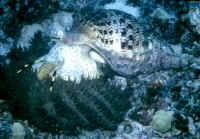 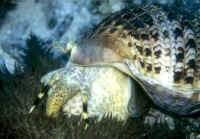
|
Bigger PIX:
The images in this table are linked
to large (desktop size) copies. Click on "framed" images
to go to the larger size. |
|
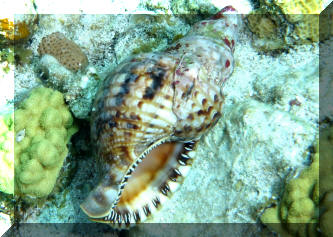
|
| Cymatium raderi
D’Attilio & Myers, 1984; Triton Snail. Tow about eight inches long.
Predatory. Caribbean to Brazil. Roatan 2017 |
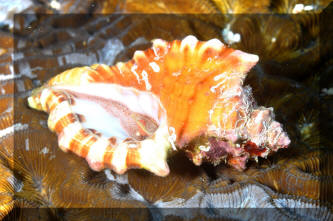
|
Family Lamellariidae (Velutinidae): http://seaslugforum.net/lamellar.htm,
Coriocella, Lamellaria, Marsenina,
Marseniopsis, and Mystinconchya.
| Coriocella hibyae,
Maldives |
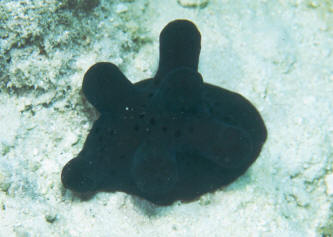
|
| Coriocella nigra, Black Velutinid.
To 4"/10cm. Internal shell; reticulate pattern. Indo-W. Pacific. Bali 2014 |
%20MD.JPG)
|
Order Neogastropoda: The Advanced Gastropods. Possess a
single monopectinate gill, and a solitary auricle and nephridium.
Triturating mechanism is a radula with three teeth to a transverse row
(termed a rachiglossate condition) and osphradia with bipectinate
folds. Entirely marine.
| Epitonium billeeanum (DuShane & Bratcher
1965). Distinctive yellow body and shell color... matching their
prey, the ahermatypic Dendrophylliid genus Tubastrea. Tropical
Indo-Pacific. N. Sulawesi pix. |
%20MD.jpg)
|
Bigger PIX:
The images in this table are linked
to large (desktop size) copies. Click on "framed" images
to go to the larger size. |
|
%20MD.jpg)
|
Superfamily Conacea (Toxoglossa). Predators with toxoglossal
radulas, poison glands, or no radula at all. Cone Shells: Conus,
Turris. Terebridae: Terebris (highly spired).
Family Conidae: (Superfamily Conacea, Toxoglossa). Predaceous
species with a toxoglossal radula or none, associated with poison
glands. The Cone Shells (Conus, Turris) and highly spired Terebridae
(Terebra). Don't touch!
| Conus abraeus Linnaeus 1758, the Hebrew
Cone. Indo-Pacific. To 2 1/2" in length. Found exposed by day
in sandy areas feeding on polychaete worms. Distinctive
"Hebrew lettering" on heavy white shells. When alive the
shell is covered with a yellowy periostracum. Found through out tropical and
temperate Indian and Pacific oceans and Red Sea. Kona
photo. |
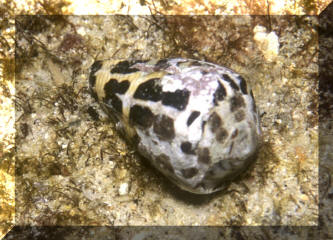
|
| Conus marmoreus Linnaeus 1758, the Marbled
Cone. Indo-Pacific. To 5" in length. Found at times exposed by
day in sandy areas feeding on other cones. This is one of a few
toxic/venomous cone species in Hawai'i. Cannot be handled
anywhere safely. This is the subspecies C. m. bandanus according to
friend/shell nut Paul Kanner. Kona, HI . |
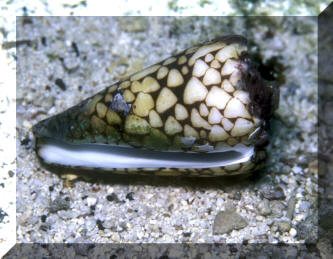
|
Bigger PIX:
The images in this table are linked
to large (desktop size) copies. Click on "framed" images
to go to the larger size. |
|
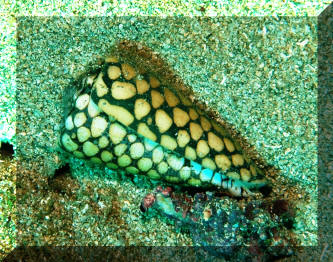
|
| Conus textile Linnaeus 1758, the Textile
Cone. Indo-Pacific; Red Sea, much of the rest of the tropical
Indo-Pac, including Hawai'i. Feeds on other prosobranch snails.
Can be fatal to humans. Red Sea image. |
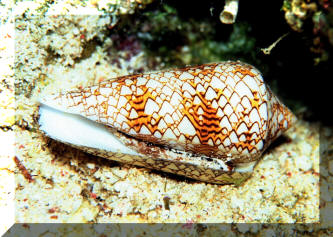
|
To: Part 1,
Part 2,
Part 3, Part 4,
Part 6, Part 7
:
 |
New Print and
eBook on Amazon
Marine Aquarium Algae Control
by Robert (Bob) Fenner
|
|
|

